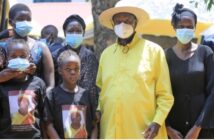The Horn of Africa is suffering the worst desert locust invasion in decades, devastating pastoralist and farming communities in Kenya, Ethiopia, Somalia, Djibouti, Eritrea, and Uganda.
South Sudan and Tanzania now are on the UN “watch list”. For Kenya, it is the worst infestation in 70 years and the worst outbreak in 25 years for Somalia and Ethiopia.
By January, data from the UN Food and Agriculture Organization (FAO) estimated nearly 110,000 hectares were affected by the desert locust crisis in the Horn of Africa. Experts have predicted, the worst is yet to come.
FAO attributes the invasion to cyclones the southern Arabian Peninsula experienced in May and October 2018, that caused heavy rainfall and gave rise to favorable locust breeding conditions in Yemen. Lack of control measures allowed three generations of breeding to migrate through Saudi Arabia, Iran, to the horn of Africa.
However, since October 2019, East African countries have experienced exceptionally heavy rains and widespread flash floods attributed to the Indian ocean dipole – a climate phenomenon in which the western part of Indian ocean near the east African coast was warmer than the eastern part.The wind sent warm moist air across the East African coast, causing heavy rainfall.
Abubakar Salih Babiker, a climate scientist at the IGAD Climate Prediction and Application Centre (ICPAC), said the Western Indian Ocean has warmed rapidly over the past 100 years and is the fastest warming part of the tropical ocean system, a trend linked to man-made global warming. The warming is causing more intense tropical cyclones in East Africa.
“October to December 2019 was the third wettest season in the past 30 years for the East Africa region. As a result, this heavy rainfall has resulted in increased green vegetation landscapes hence plenty of food for the locusts. The temperatures are warm aiding their egg hatching, and with the good winds, the conditions are suitable for their spread and movement,” Babiker said.
The crisis is far from over.
ICPAC’s Fifty-Fourth Greater Horn of Africa Climate Outlook Forum predicts a wetter and hotter than usual March to May season in a wide area within the horn of Africa. Already the region is experiencing above-average rainfall during the summer season, which began in January.
Cyril Ferrand, FAO resilience team leader for eastern Africa, said the countries have a vast swarm of desert locusts now maturing and laying eggs on the ground. And the rains complicate desert locust control as it is not suitable to spray insecticides during rains.
“Within the next three months, we could potentially have a 20 times bigger problem than we have now,” Ferrand said, given typical population growth if eggs hatch and the vast new generation of insects manages to find enough food and reproduce. And in six months “we could have 400 times bigger swarms if we do not work on the control now,” he said.
Stephen Njoka, director of the Desert Locust Control Organisation for Eastern Africa, said one female could lay eggs three times, with each pond containing up to 100 eggs. “It is a big challenge as they are billion mobile swarms, some already laying eggs.” Njoka said female desert locusts can lay eggs at least three times in their lifetime, usually at intervals of about 6-11 days.
Esbon Agira, a plant protection officer at the ministry of agriculture, livestock, and fisheries in Kenya, said the local monitoring team ministry has identified four areas in northern Kenya where the desert locusts have laid eggs – in Marsabit, Samburu and two spots in Isiolo.
Agira said controlling bands of young locusts, known as hoppers, will be easier as they do not have wings for about two weeks. “But the challenge is identifying where the locusts are laying eggs.”
To boost on-ground surveillance capacity in Kenya, FAO Kenya has stated training 600 people as part of the National Youth Service (NYS) in collaboration with Moroccan desert locust experts.
Ferrand admitted the desert locust mapping and monitoring in Kenya, Ethiopia and Sudan is currently “sketchy.” “The control operation is still to be improved as we do not have all the means to control, survey, and conduct ground monitoring, but we are building this capacity.”
Ferrand said FAO was working with countries and the Desert Locust Control Organisation for Eastern Africa to build capacity for on-ground monitoring teams. The teams require GPS radios to monitor and map the movement of the swarms of yellow-coloured mature insects, since the colour indicates the areas where they are likely to lay eggs. But the biggest threat is yet to come, Ferrand warned.
“It is a race against time to have all the capacity in place to control the next generation of locust at the time the farmers are planting cereals in March and April. We are urging donors to allocate resources now instead of June,” he said.
Kenya has an on-ground monitoring team in every county, identifying and reporting the swarm activities. While the situation is mostly under control, according to Agira, incoming swarms from Somalia are a threat to efforts conducted so far.
“If there is still no control in Somalia and Yemen, new swarms and unidentified hatchings will continue being a significant threat,” he said.
FAO is requesting $76 million for Kenya, Somali, Ethiopia, Djibouti, and Eritrea. Ferrand said the figure will rise as more resources for controlling and supporting affected communities’ livelihoods will be required.
New breeding could worsen the food security current situation for about 13 million people in Somalia, Kenya, and Ethiopia who are currently critically food insecure. With economies of East African countries reliant on agriculture, economies have suffered.
As the world’s largest exporter of black tea and the second-largest exporter of fruit and vegetables, the country, which is highly dependent on these exports, is now facing the threat of a depreciation of the Kenyan shilling, which could complicate the repayment of the government debt — 62% of GDP in June 2019. It is a catastrophe, but it could become more worse.



